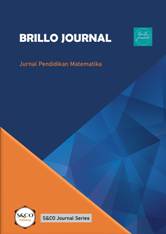Exploring Exponential Functions Using Geogebra
DOI:
https://doi.org/10.56773/bj.v3i1.45Keywords:
Analysis, Exponential functions, GeoGebra, VisualisationAbstract
Exponential functions, symbolized by the expression f(x)=ax, are a fundamental mathematical concept widely applicable to real-world scenarios such as population growth, compound interest, and radioactive decay. This abstract underscores the significance of exponential functions and highlights GeoGebra's crucial role in interactive visualization and analysis as an intuitive mathematical software. This study utilizes GeoGebra's dynamic interface to explore and comprehend exponential functions, bridging the gap between theoretical concepts and practical applications. It includes a comparative analysis between classical methods and GeoGebra solutions for exponential functions. The software's ability to validate mathematical outcomes through visual confirmation is explored, emphasizing its role in not only enhancing understanding but also providing a reliable means of verification. GeoGebra and mathematical analysis illustrations consistently yield results through practical examples, demonstrating the software's effectiveness in fostering a deeper understanding of exponential growth. In addition, surveys was conducted and engaged in direct comparison of solutions with students in the classroom setting to observe firsthand how learners interact with the material and identify common mistakes made during problem-solving. The survey results informed the development and refinement of the approach, ensuring a comprehensive understanding of both the benefits and challenges associated with learning exponential functions through GeoGebra.
References
Aliu, A., Rexhepi, S., & Iseni, E. (2021). Analysis and comparison of commitment, homework, extra hours, preliminary grades and testing of students in Mathematics using linear regression model. Mathematics Teaching Research Journal, 13(3), 21-52.
Boyce, W. E., & DiPrima, R. C. (2016). Elementary differential equations and boundary value problems. Wiley.
BYJU'S. (2015). Exponential Functions. BYJU'S Learning Program. https://byjus.com/maths/exponential-functions/#:~:text=An%20exponential%20function%20is%20a%20Mathematical%20function%20in%20the%20form,is%20approximately%20equal%20to%202.71828
Carreira, S., Jones, K., Amado, N., Jacinto, H., & Nobre, S. (2016). Youngsters Solving Mathematical Problems with Technology: Their Experiences and Productions. Youngsters Solving Mathematical Problems with Technology, (pp. 21-53). Springer Cham. https://doi.org/10.1007/978-3-319-24910-0
Chen, J. (2021, October 18). Exponential Growth: Definition, Examples, Formula to Calculate. Investopedia. https://www.investopedia.com/terms/e/exponential-growth.asp
FlexBooks. (2022, November 17). Exponential Growth & Decay Functions. CK-12 Interactive Algebra 2. https://flexbooks.ck12.org/cbook/ck-12-interactive-algebra-2/section/5.3/primary/lesson/exponential-growth-decay-functions-17947037/
Hohenwarter, M., & Preiner, J. (2017). Dynamic Mathematics Software in Teaching and Learning: GeoGebra. In Handbook of Research on Cross-Cultural Business Education (pp. 303-329). IGI Global.
Kamberi, S., Latifi, I., Rexhepi, S., & Iseni, E. (2022). The influence of practical illustrations on the meaning and operation of fractions in sixth grade students, Kosovo-curricula. International Electronic Journal of Mathematics Education, 17(4), em0717. https://doi.org/10.29333/iejme/12517
Keown, A. J. (2020). Personal Finance: Turning Money into Wealth. Pearson
Larson, R., & Edwards, B. (2018). Calculus. Cengage Learning.
Lumen Learning. (2008). Horizontal and Vertical Translations of Exponential Functions. https://courses.lumenlearning.com/waymakercollegealgebra/chapter/horizontal-and-vertical-translations-of-exponential-functions/
Marecek, L., & Anthony-Smith, M. (2023, March 9). Graphs of Exponential Functions. LibreTexts. https://math.libretexts.org/Courses/Borough_of_Manhattan_Community_College/MAT_206.5/05%3A_Exponential_and_Logarithmic_Functions/5.03%3A_Graphs_of_Exponential_Functions#:~:text=is%20y%3D0.-,Graphing%20Transformations%20of%20Exponential%20Functions,x%20without%20loss%20of%20shape
MATHguide. (2017, December 18). Exponential Functions. https://www.mathguide.com/lessons3/ExpFunctions.html
MATHguide. (2021, April 15). Transforming Exponential Functions. https://www.mathguide.com/lessons3/ExpFunctionsTrans.html
Ministerstvo za Obrazovanie i Nauka. (2002). Nastavna Programa Po Matematika III godina. https://www.bro.gov.mk/wp-content/uploads/2018/02/Nastavna_programa-Matematika-III_GO-mkd.pdf
Mollakuqe, V., Rexhepi, S., & Iseni, E. (2020). Incorporating GeoGebra into teaching circle properties at high school level and it’s comparison with the classical method of teaching. International Electronic Journal of Mathematics Education, 16(1), em0616. https://doi.org/10.29333/iejme/9283
Nagwa. (2023). Lesson Explainer: Exponential Growth and Decay. https://www.nagwa.com/en/explainers/320150304701/
Nanda, V. (2023, April 18). Difference Between Exponential Growth and Exponential Decay. Tutorialspoint. https://www.tutorialspoint.com/difference-between-exponential-growth-and-exponential-decay
Nykamp, D. Q. (2020). The exponential function. Math Insight. https://mathinsight.org/exponential_function
Rudin, W. (1987). Real and Complex Analysis. McGraw-Hill Education
Stewart, J. (2015). Calculus: Early Transcendentals. Cengage Learning.
Stewart, J., Redlin, L., & Watson, S. (2018). Precalculus: Mathematics for calculus. Cengage Learning.
Turito. (2022, March 24). Exponential Growth and Decay: Definition, Graph, Formula, Examples. https://www.turito.com/learn/math/exponential-growth-and-decay
Zulnaidi, H., Oktavika, E., & Hidayat, R. (2020). Effect of use of GeoGebra on achievement of high school mathematics students. Education and Information Technologies, 25, 51-72. https://doi.org/10.1007/s10639-019-09899-y
Downloads
Published
How to Cite
Issue
Section
License
Copyright (c) 2023 Shpresa Tuda, Shpëtim Rexhepi

This work is licensed under a Creative Commons Attribution 4.0 International License.
The authors agree that this article remains permanently open access under the terms of the Creative Commons Attribution 4.0 International License




